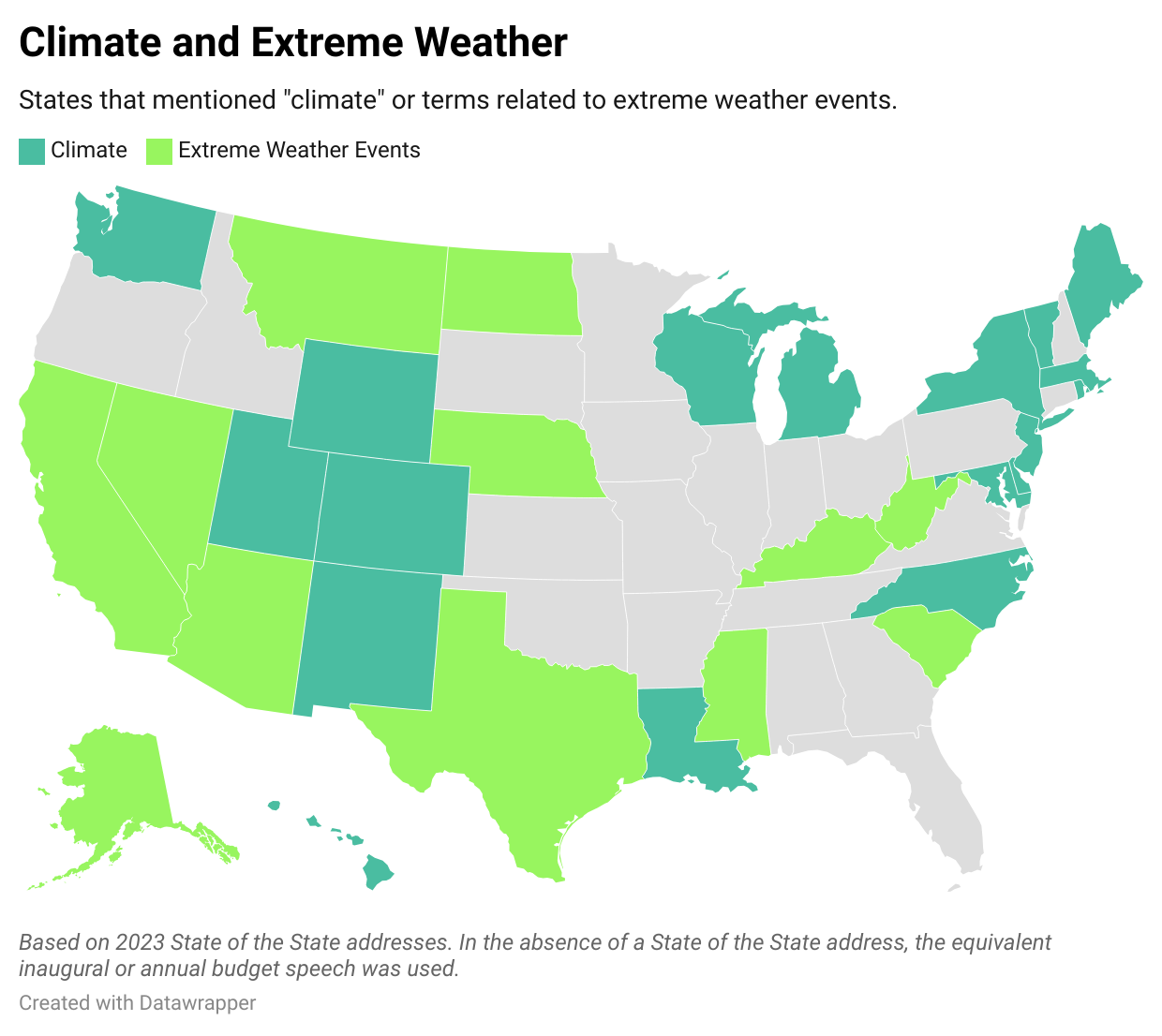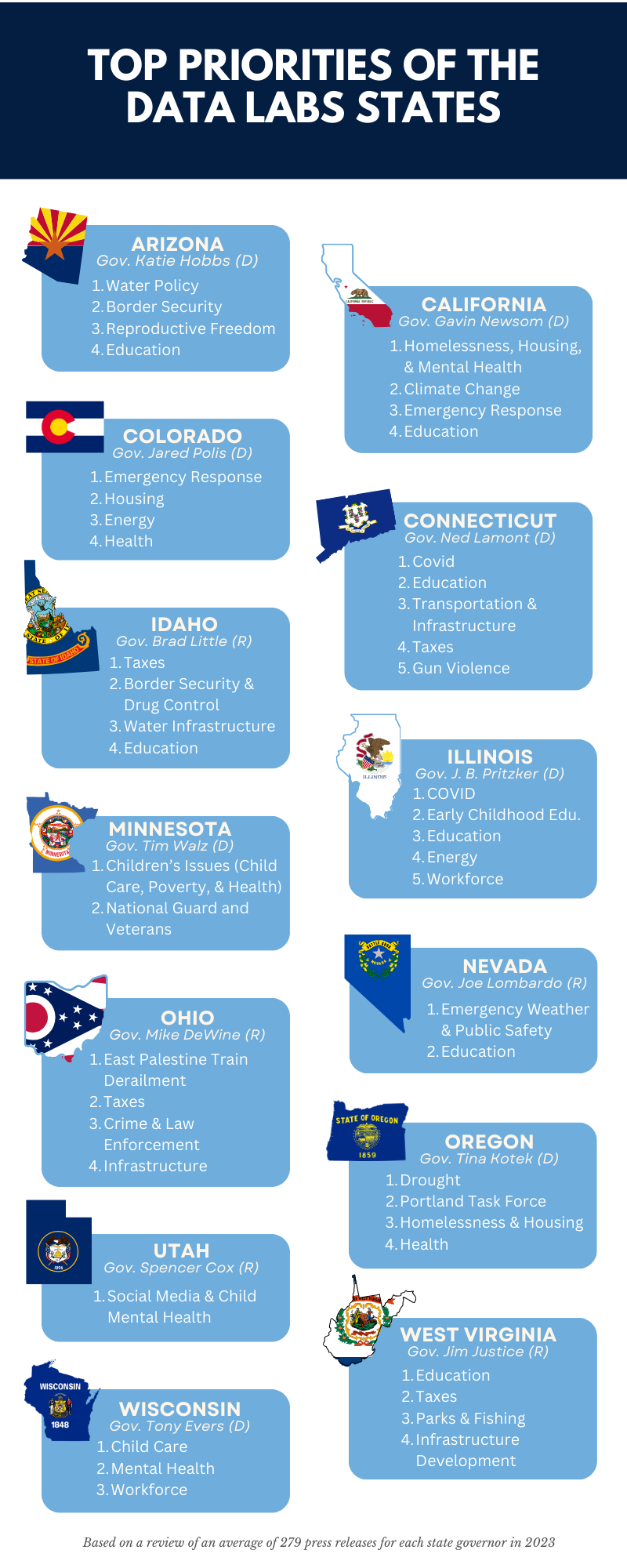The State of the States: What Governors across the US Prioritized in 2023
“Today in 2023, the State of our state is undeniably strong, but we know it can be even stronger, for our potential is truly limitless.”
– Colorado Governor Jared Polis
Each year, the “State of the State” speech is a governor’s prime opportunity to outline their top priorities to the public. While most analyses of these speeches focus on a single state or topic (like education), analyzing these addresses collectively uncovers common themes and priorities that transcend individual states, revealing insights into broader national trends.
The Beeck Center for Social Impact + Innovation analyzed all 50 2023 State of the State addresses (or the equivalent annual budget address or inaugural speech) and dove deeper into governor’s priorities by analyzing a year’s worth of press releases for the 13 states that have participated in our Data Labs program.
The priorities listed in this analysis are not exhaustive, but reflect the terms that governors used most frequently.1
Overall Priorities from the State of the State Speeches
A number of top policy priorities emerged from this analysis, including:
- Affordable housing and homelessness
- Energy policy
- Taxes
Examining Democratic and Republican governors separately, top policy priorities shifted slightly, with Republicans highlighting issues related to education, energy, and property, while Democrats focused more on housing issues, mental health, and water policy. Both emphasized taxes, workforce, and “kids.”
Affordable Housing and Homelessness
In states with high population density and cost of living, housing and homelessness was understandably a high priority. For example, during his annual speech, Hawaii Governor Josh Green (D) signed an emergency proclamation on homelessness. However, even states with a lower cost of living prioritized housing issues, such as Montana Governor Greg Gianforte (R) who underscored home-ownership as a key aspect of the “American Dream” and highlighted the work of the bipartisan Housing Task Force.
Energy Policy
Second to housing issues was energy policy, both in terms of addressing what New Hampshire Governor Chris Sununu (R) called a “national energy crisis” for home energy costs and in terms of advancing clean energy initiatives. Louisiana Governor John Bel Edwards (D), whose state makes up about one-sixth of the nation’s refining capacity, both emphasized his support for “companies meeting the current market demand for oil and gas” and also heralded Louisiana as a “global leader in the energy transition” with the state’s Climate Initiatives Task Force.
Taxes
As highlighted previously, governors from both political parties focused on taxes. For example, Idaho Governor Brad Little (R) specifically highlighted his $2.7 billion tax relief efforts through changes in small business payroll, grocery, property, and income taxes. Meanwhile Rhode Island Governor Dan McKee (D) called attention to his child tax rebate, a reduction in property taxes, and the elimination of taxes on cars and military pensions. Overall, governors of California, Georgia, Kentucky, Oregon, and Wyoming did not mention taxes at all, while governors from Montana, Idaho, Illinois, Nebraska, and Colorado mentioned taxes the most.
Emergent Policy Priority: Climate Change and Extreme Weather Events
Although climate change itself did not emerge as a top policy priority in our overall analysis, many governors—especially Democrats—still explicitly discussed the threat of climate change, with Massachusetts Governor Maura Healey (D) announcing the appointment of “the country’s first Cabinet-level climate chief.” The term “climate change” is often politicized, but many governors are still exploring this issue through the lens of extreme weather events, such as hurricanes, tornados, droughts, etc. Research shows that climate change affects both the frequency and intensity of extreme weather events. Thus, when considering both climate and extreme weather phrasing, 60 percent of state governors expressed concern about the changing climate. Considering the increasing concern among younger generations and President Biden’s Climate Agenda, climate change is likely to become an even higher priority among states in the coming years.

A Look at Press Releases: A Deep Dive into Governor Priorities over Time
Like the annual State of the State address, press releases are valuable tools for governors to communicate their priorities throughout the year. Because collecting all press releases for every state is a time-consuming process, we focused on releases from the last year from the 13 states that have participated in our Data Labs program—Arizona, California, Colorado, Connecticut, Idaho, Illinois, Minnesota, Nevada, Ohio, Oregon, Utah, West Virginia, and Wisconsin.
In addition to reiterating many of the top priorities outlined above, the press release analysis revealed priority areas less frequently addressed in the State of the State addresses, including infrastructure, emergency issues, health, early childhood education and care, COVID, and border security. Reviewing public affairs materials over time can give a more accurate idea of what policies or issues governors actually focused on the most. For example, Ohio Governor Mike DeWine‘s top priority was addressing concerns about water safety and health after the East Palestine train derailment released hazardous chemicals later that year.
Through the Data Labs program, the Beeck Center has supported states with issue areas that have strong governor support, including student outcomes, housing and homelessness, workforce support, and safety net benefits. Employing an analysis such as this is a useful approach in understanding evolving state policy priorities and making informed choices when designing interventions and building state capacity. To see the breakdown of top priorities for all 13 state governors, see the infographic below.

Broader Implications and Takeaways
This analysis offers a snapshot of the evolving policy landscape in the United States. It’s clear that governors are focused most on issues of affordable housing and homelessness, energy policy, taxes, and mental health and gun violence. We’re also seeing a pivot to focus on climate change and other emerging issues. Ultimately, we hope this analysis leaves you with some key takeaways:
- For governors and state-level government actors, this can help you understand how the public may perceive governor’s priorities based on press releases and public remarks and compare these to priorities outlined by other governors.
- For non-governmental or advocacy organizations, examining speeches and press releases can illuminate the issues most likely to get support from executive leadership.
- For public policy researchers, employing data science techniques can enhance your review of written materials and allows for analysis of more information in a shorter time.
1To view the underlying code and a more detailed methodology description, visit the GitHub repository.